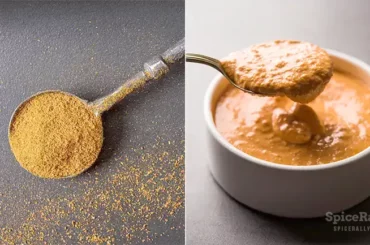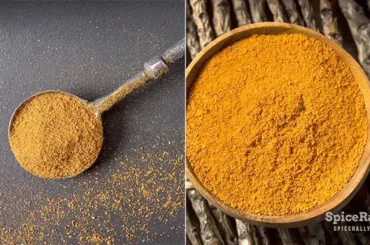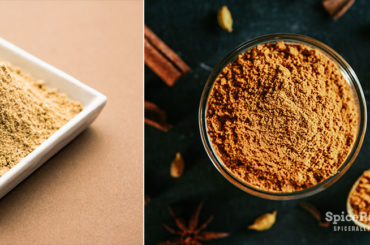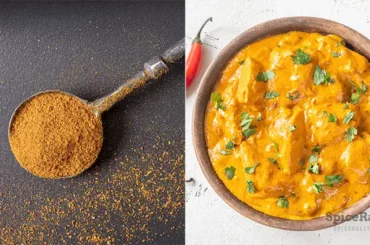Things often tend to mix up when we cook using spice blends, especially if they seem to be similar by any means. Therefore, SpiceRally thought of dedicating this article to everyone who needs to be sophisticated with curry powder vs chili powder.
The key difference between chili powder and curry powder comes down to their heat level and flavor profiles. In fact, chili powder is based on hot red chili peppers. And the chili powder variant which is often used in Western cuisine contains complementary spices and herbs for added flavor. At the same time, curry powder is merely based on some dried spices, whereas red chilies are only a secondary element.
What else do you need to learn about these two spice powders? Keep reading as we have tackled all about curry powder and chili powder.
| Curry Powder | Chili Powder | |
|---|---|---|
| Base Ingredients | Turmeric | Dried red chili powder made from hot smoked paprika/ancho/ Mexico/ Cascabel/ guajillo/ chipotle/pasilla/ Kashmiri red chili peppers. |
| Other Ingredients | – Coriander seeds – Red chilies (cayenne pepper/paprika/ Kashmiri red chilies) – Fenugreek – Garlic – Cumin seeds – Black pepper – Mustard seeds – Cloves – Ginger – Cinnamon Some types might also contain: – Cardamoms – Allspice – Nutmeg – Curry leave – Bay leaves – Fennel seeds | Chili powder used in Western cuisine often includes: – Garlic powder – Ground cumin – Onion powder – Dried oregano – Salt |
| Base Flavor | Spicy and savory | Hot and spicy |
| Flavor Profile | Bolder, profound, and richer in flavor when compared to chili powder with a mildly warm, earthy, and savory bite. | Less flavorful than curry powder. Mild to moderately spicy with hot, fiery, smoky, and earthy flavor notes that make the “Tex-Mex” flavor profile unique to chili powder. |
| Texture | Dry mixture | Dry mixture |
| Usages in cooking | – With fish, meat, egg, and other seafood dishes – To mix into curries – To be incorporated into the fillings of fried food/snacks. – With chutneys and salads In savory rice dishes – To use as a dry rub and an ingredient in marinades or wet rubs. | – As a key ingredient in chili – To be incorporated with sauces – As a meat, fish, and seafood seasoning, dry rub, or an ingredient in wet rubs and marinades. – With other slow-cooking meat dishes In soups and stews – As an ingredient in other seasoning blends |
| Origin | Western cuisine (Known to be an Indian-inspired British invention) | American cuisine |
| Availability | – Comes in containers/bottles and packets – Readily available in any local grocery store, supermarket, and online shopping site. | – Comes in containers/bottles and packets – Readily available in any local grocery store, supermarket, and online shopping site. |
| Storage | – Once opened, store in an air-tight glass container in a dry, cool, dark place. – Can be kept in your spice cupboard with the rest of your spices. | – Once opened, store in an air-tight glass container in a dry, cool, dark place. – Can be kept in your spice cupboard with the rest of your spices. |
| Category of food | Spice blend | Spice blend/ seasoning |
Curry Powder vs Chili Powder- Differences Elaborated.
There are multiple differences between these two spice blends starting from their colors to their taste. At a glance, curry powder typically has an eye-soothing gentle yellow color, while chili powder looks fiery with a deep reddish tone.

Moreover, as mentioned earlier, the chili powder variant used in Western cuisine is hotter than curry powder, with hot red chili peppers as its base ingredient, a few spices, herbs, and other elements used as supportive flavors.
However, Asian cuisine often uses a version of “red chili powder” made by pulverizing one or more types of red chili peppers. And this variation does not include any other spices, herbs, or flavorings.
In converse, curry powder is lower in heat level since it is a blend of spices and sometimes a herb or two. But chili pepper is just another secondary ingredient since the base flavoring of curry powder is turmeric.
Conclusion
As you see, just because both of them have the word “powder” in them, they are not the same! In fact, curry powder is remarkably different from chili powder in terms of heat, flavor, ingredients, and purpose of cooking.




